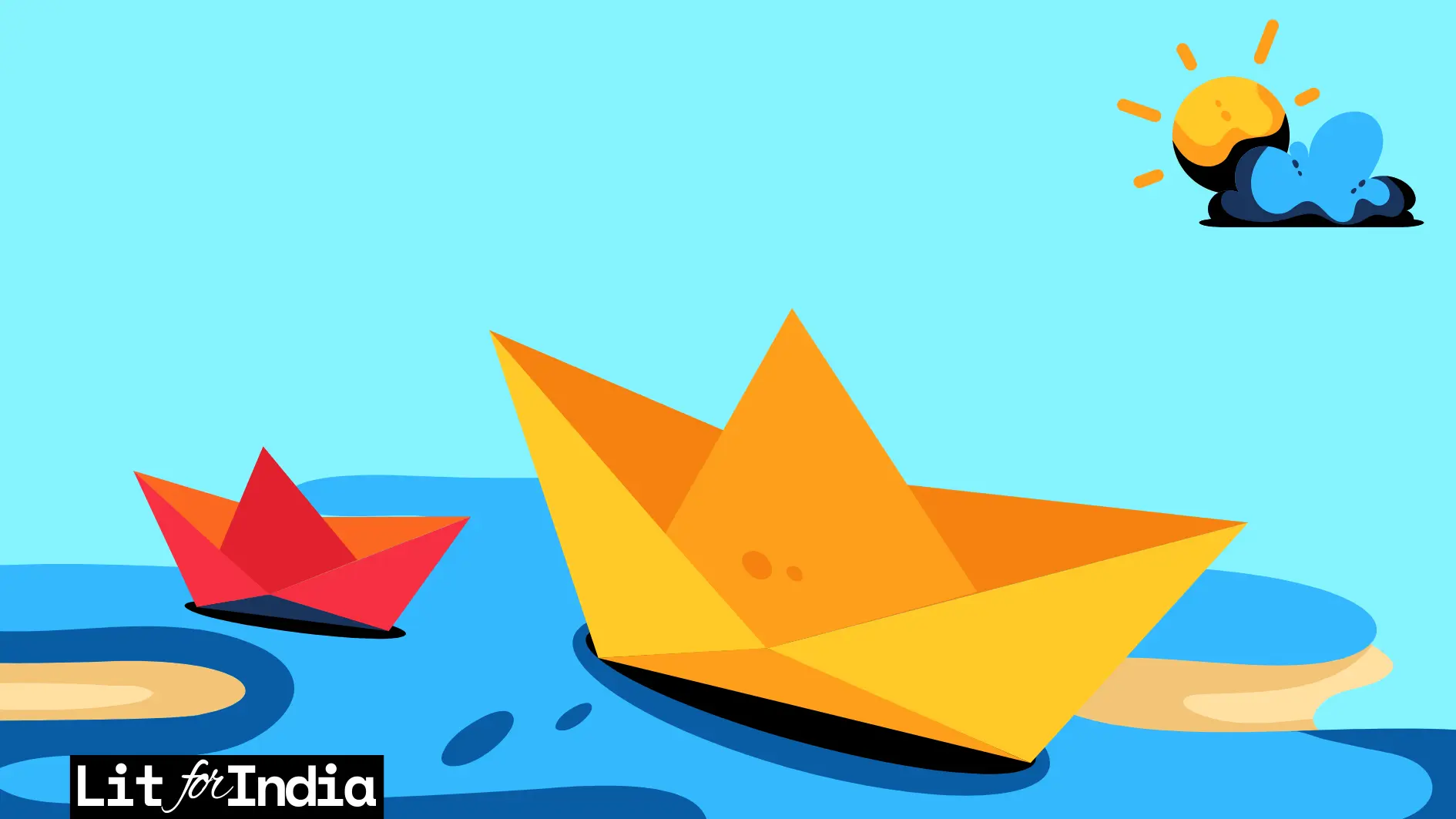Rabindranath Tagore’s “Paper Boats” (1913) is a beautiful poem that captures the essence of childhood wonder and imagination. Through the simple act of sending paper boats down a stream, the speaker, a child, embarks on a journey of dreams and exploration. Rabindranath Tagore’s “Paper Boats” is a poem most often associated with childhood innocence – a simple act of folding paper transformed into a vessel for dreams. But what if we shifted our focus? The poem revolves around a child’s simple act of making paper boats and sending them adrift on a stream. This seemingly mundane activity becomes a vessel for the child’s hopes, dreams, and yearning for connection. In this blog, we are going to discuss the summary and analysis of the poem Paper Boats in detail.

Table of Contents
Paper Boats by Rabindranath Tagore
Day by day I float my paper boats one by one down the running stream.
In big black letters I write my name on them and the name of the village where I live.
I hope that someone in some strange land will find them and know who I am.
I load my little boats with shiuli flower from our garden, and hope that these blooms
of the dawn will be carried safely to land in the night.
I launch my paper boats and look up into the sky and see the little clouds setting thee white bulging sails.
I know not what playmate of mine in the sky sends them down the air to race with my boats!
When night comes I bury my face in my arms and dream that my paper boats float on
and on under the midnight stars.
The fairies of sleep are sailing in them, and the lading in their baskets full of dreams.
Summary of the Poem Paper Boats
In Rabindranath Tagore‘s “Paper Boats,” a child creates a daily ritual of crafting paper boats, inscribing them with their name and village, and setting them afloat on a stream. These boats become vessels for the child’s dreams and hopes. The poem uses symbolism: the flowing water represents the unknown journey of the child’s aspirations, while the boats themselves embody their fragility. The child’s yearning for connection beyond their village is evident in their bold lettering and the hope that someone far away might find the boats.

Tagore further expands the child’s world by comparing the paper boats to the clouds sailing across the sky. This sparks the child’s imagination, creating a sense of wonder and a playful race between the two. The poem ends with the child dreaming of the boats journeying under starlight, suggesting their dreams continue to sail even in sleep. “Paper Boats” celebrates childhood innocence and the boundless power of imagination. It captures the universal human desire for connection and the hope that even the simplest dreams can carry us far.
Analysis of the Poem Paper Boats
Stanza 1
Day by day I float my paper boats one by one down the running stream.
Analysis: The poem opens with the speaker describing the act of floating paper boats down a stream. This action symbolises the innocence and simplicity of childhood play. The running stream suggests the passage of time and the continuous flow of life.
Stanza 2
In big black letters I write my name on them and the name of the village where I live.
Analysis: Here, the speaker adds a personal touch to the paper boats by writing their name and the name of their village on them. This act imbues the boats with identity and a sense of belonging, making them more than just objects but extensions of the self and one’s roots.
Stanza 3
I hope that someone in some strange land will find them and know who I am.
Analysis: The speaker expresses a hope that these paper boats will travel far beyond their immediate surroundings and reach someone in a distant land. This reflects the universal desire for recognition and connection, even in childhood fantasies.
Stanza 4
I load my little boats with shiuli flower from our garden, and
hope that these blooms of the dawn will be carried safely to land in the night.
Analysis: Shiuli flowers, known for their fragrance and association with the dawn, are placed in paper boats. This addition heightens the poetic imagery and adds a layer of beauty and fragrance to the boats. The hope that these flowers will reach distant lands underscores the innocence and optimism of childhood dreams.

Stanza 5
I launch my paper boats and look up into the sky and see the little clouds setting thee white bulging sails.
Analysis: The act of launching the paper boats is likened to sailing ships. The clouds are metaphorically compared to sails, suggesting a playful imagination where even the sky becomes part of the adventure. This imagery enhances the theme of childhood imagination and the vast possibilities perceived by young minds.
Stanza 6
I know not what playmate of mine in the sky sends them down the air to race with my boats!
Analysis: The speaker wonders about the unseen forces—perhaps celestial playmates—that interact with the paper boats. This adds a touch of mystery and wonder to the poem, highlighting the magical realism inherent in childhood perceptions.
Stanza 7
When night comes, I bury my face in my arms and dream that my paper boats float on
and on under the midnight stars.
The fairies of sleep are sailing in them, and the lading in their baskets full of dreams.
Analysis: The line “When night comes” marks a clear shift from the daytime activity of making and launching boats to the introspective world of sleep. Burying their face in their arms suggests a moment of surrender to slumber. Let us analyse more into the last stanza.
Themes
The Persistence of Dreams: Despite the day’s activities ending, the dreams associated with the paper boats continue. The child doesn’t simply dream; they dream that their paper boats float on. This emphasises the enduring nature of their hopes and aspirations.
Midnight Stars: The setting is no longer the bright daylight under which the boats were launched. Now, they sail under the “midnight stars,” a vast and mysterious expanse. This imagery evokes a sense of wonder and the infinite possibilities that await the child’s dreams.

The Introduction of Fairies: The poem takes a fantastical turn with the introduction of “fairies of sleep.” These mythical creatures personify the act of dreaming itself. Their presence adds a touch of magic and wonders to the child’s sleep, suggesting that dreams are not random occurrences but guided by benevolent beings.
The Cargo of Dreams: The fairies are not simply passengers; they are “sailing in” the boats, actively steering them. Their cargo is a precious one – “baskets full of dreams.” This imagery suggests that dreams are not formless wisps but tangible things.
Conclusion
In “Paper Boats,” Tagore masterfully intertwines the innocence of childhood with the profound yearnings of the human spirit. The poem with its simple imagery and deep symbolism, reflects the poet’s longing for connection and recognition beyond his immediate world. As we float through the verses, we are reminded of the ephemeral nature of our dreams and aspirations, and the universal desire to be remembered and understood. Tagore’s delicate portrayal of a child’s play transforms into a meditation on life’s transient beauty and the enduring hope that our small efforts will find resonance in distant hearts. This timeless piece continues to inspire readers to cherish their dreams and believe in the unseen bonds that link us all.

